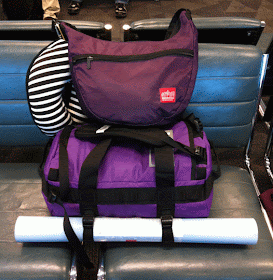This is an excellent question! Many of us have probably heard yoga teachers talk about the importance of not locking the knees in standing and balance poses. Without going into too much anatomical detail, this is important for the following reasons:
- If your knee is locked in a balance pose, it means that the joint is holding the weight of the body, instead of the muscles. In the long run, this can wear down the protective cushioning around the knee (called the meniscus) and cause wear and tear on the joint, which can lead to pain, injury and possibly conditions like arthritis.
- If your knee is locked in a weight-bearing standing pose, for example triangle pose, the joint is again at risk, but in addition, because you are now stretching as well as bearing weight, the ligaments and tendons surrounding the knee joint are also at risk of taking the strain of the stretch, instead of the muscles. Since ligaments and tendons are meant to stabilise, not to stretch, this can quickly lead to injury - and a torn or injured ligament takes far, far longer to heal than a similarly injured muscle.
So, here is a simple 2-step tip on how to keep the legs straight without locking the knee in standing or balancing poses.
Step 1: Build awareness
In the pose you are working with, lift your toes - just your toes! - off the mat.
Yep, that's it - try it! You'll find that it's pretty much impossible to lock the knee while lifting the toes at the same time, because lifting the toes creates muscular engagement, or "hugging in," that brings the weight of the body into the muscles instead of the joint.
Now of course, in the long run, you don't want to be going through your entire practice with your toes lifted up! It's just a "cheat" to get your muscles used to working in a new way. So once you have built an awareness of what that muscular engagement feels like, you should work towards a techinque called "isometric" or "static" muscular engagement - essentially, engaging a muscle from the inside, without actually moving the body. You might have heard yoga teachers cue this kind of engagement by talking about "hugging the muscles to the bone."
This is Step 2: Isometric engagement of the leg muscles.
To work on isometrically engaging the muscles in your legs, practice this simple sequence. As you move to each step, remember to keep the muscle engagement from the previous step! I find it's best to start practicing this in Tadasana (standing mountain pose), and once you have a good sense of how it feels, then you can apply the same sequence to all your other standing poses.
- Begin in a standing pose with a neutral pelvis.
- Establish an even weight distribution between the outer edge, inner edge, and heels of your feet, lifting your toes up to do so if it helps. Press strongly through the big toe mound in order to lift your arches.
- Keep that engagement and then without moving your feet, try to engage your muscles as if you wanted your toes to lengthen forwards and your heels to draw back.
- Next, imagine your shins drawing forward.
- Now, engage your muscles as if to squeeze an imaginary yoga block or tennis ball in between your thighs, lifting your kneecaps upwards and drawing the thigh muscles up and back.
- Finally, engage your muscles as if you wanted to lift your pelvis away from the tops of your femurs. This one is tricky - just visualise it, even if you can't feel anything happening.
These 6 steps can work to bring engagement to the subtle leg muscles in nearly every standing pose (and even in inversions!), which ultimately will strengthen your standing poses without putting your knee joint at risk.
Here is a quick graphic that you can use as a reminder of the main points:
(and do forgive me the not-so-great alignment of my pelvis in this picture!)
**NB: If you are hyperflexible or have hypermobile knee joints, you will probably need to work with a slight bend in the knee until you can really control the muscular engagement of your legs to fully protect the knee joint. Work with a yoga therapist or a knowledgeable teacher to determine the right way of working for you.
~~~~~~~~~~~~~~~~~~~~~~~~~~~~
If you've read this far, I'd love your feedback! Was this tip helpful? Is there anything else you'd like tips about? Leave a comment!









